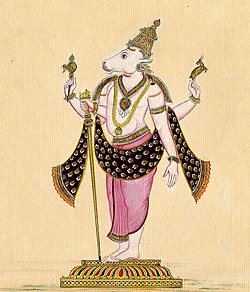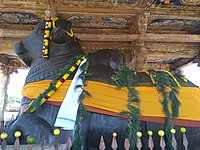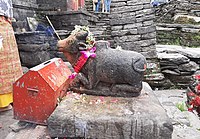Nandi (Hinduism)
| Nandi | |
|---|---|
 Nandi in a zoo-anthropomorphic form | |
| Affiliation | Mount of Shiva |
| Abode | Mount Kailash |
| Consort | Suyasha[1] |
| Part of a series on |
| Shaivism |
|---|
 |
|
|
Nandi (
, the abode of Shiva. Almost all Shiva temples display stone images of a seated Nandi, generally facing the main shrine.Etymology
The Sanskrit word nandi (
The application of the name Nandi to the bull (Sanskrit: Vṛṣabha) is a development of recent syncretism of different regional beliefs within Shaivism.[3] The name Nandi was widely used instead for an anthropomorphic door-keeper of Kailash, rather than his mount in the oldest Shaivite texts in Sanskrit, Tamil, and other Indian languages. Siddhanta texts distinguish between Nandi and Vṛṣabha.[4]
Legend
Nandi is described as the son of the sage Shilada. Shilada underwent severe penance to have a boon– a child with immortality and blessings of Shiva, and received Nandi as his son. Shiva Purana says that Nandi was born from a yajna performed by Shilada.[5] Nandi grew up as an ardent devotee of Shiva and he performed severe penance to become his gate-keeper, as well as his mount, on the banks of river Narmada. According to regional legend, this site is identified with the Tripur Tirth Kshetra in present-day Nandikeshwar Temple, in Jabalpur, Madhya Pradesh.
According to
Many
The ancient Tamil text Tiruvilaiyadal Puranam mentions another story in which Nandi is incarnated as a whale.[10] According to this legend, Parvati lost her concentration while Shiva was explaining the meaning of the Vedas to her. Parvati, then incarnated as a fisher-woman to atone for her lack of concentration. To unite his master and his beloved-wife, Nandi took the form of a whale and started to trouble the people. Parvati's father declared that the man who would kill the whale would marry his daughter. Later, Shiva took the form of a fisherman and killed the whale, and received Parvati in her previous form.[11]
The
Iconography
The
The white color of the bull symbolizes purity and justice. Symbolically, the seated Nandi faces the sanctum in Shiva temples and represents an individual
Nandi Flag

Nandi flag or Vrshabha flag, a flag with the emblem of seated bull is recognized as the flag of Shaivism, particularly among Tamil community all over the world. Nandi was the emblem of historical Tamil Shaiva monarchs, such as
The Nandi flag used nowadays was designed by Ravindra Sastri of
Gallery
-
Decorated Nandhi at temple in Thanjavur
-
2nd-century CE sculpture of a Nandi in Mysore
-
Nandi at Gangaikonda Cholapuram
-
Nandi at Tungnath Mandir
-
Nandi at Mysore
-
Nandi at Prambanan, Java, Indonesia
-
decorated
See also
- Kamadhenu
- Cattle in religion
- Gavaevodata, the primordial cow in Zoroastrianism
- Kao (bull)
References
- ISBN 9788120808775.
- ^ "Monier Williams' Sanskrit-English". Retrieved 5 March 2017.
- ^ Gouriswar Bhattacharya, (1977), "Nandin and Vṛṣabha", Zeitschrift der Deutschen Morgenländischen Gesellschaft, Supplement III,2, XIX. Deutscher Orientalistentag, pp. 1543–1567.
- ^ Sabaratnam Sivacharyar, S.P. Shrimat Kamigagamah Purva Pada (Part One). USA: The Himalayan Academy, Kauai Adheenam. pp. 4:471–500. Archived from the original on 5 July 2020. Retrieved 14 February 2018.
- ISBN 978-81-261-3630-8.
- ^ "IN THE LAND OF THE SIDDHAS". www.sutrajournal.com. Retrieved 14 April 2023.
- ISBN 978-1-934145-40-1.
- ISBN 978-0-945497-89-9.
- ISBN 9788170172284.
- ^ Indian Association for English Studies (1995). The Indian Journal of English Studies, Volume 34. Orient Longmans. p. 92.
- ^ The Indian Journal of English Studies. Orient Longmans. 1995. p. 92.
- The Walters Art Museum.
- ISBN 978-1-62055-249-0.
- ^ DBS.Jeyaraj (2013). Reviving Practice of Hoisting 'Nandi' (Crouched Bull) Flag As Hindu Festivals and Functions.
- ^ a b c Kalabooshanam Chelvathamby Manickavasagar (2008). "Fourth International Saiva Siddhantha Conference and the Glory of Nanthy Flag". The Island. Retrieved 5 March 2017.
- ISBN 81-206-0210-2.
- ^ "Hiduism Today, (2008), Hindu Campaigns for Restoration of Nandi Flag Tradition". Retrieved 5 March 2017.
- ^ a b Taṉapālā, kalāniti., Ciṉṉatturai., (2013), "Nantikkoṭi ēṟṟīr! Koṭikkavi pāṭīr!", Omlanka Publication.
- ^ a b Ciṉṉatturai taṉapālā, (2008), "nantikkoṭiyiṉ mukkiyattuvamum perumaikaḷum", Manimekalai Publication.
- ^ "Nanthi Flag to Maithripala Sirisena". Retrieved 5 March 2017.
- ^ "Minister Swaminathan urged to Provide Nanthi Flags to Temples, Societies". Retrieved 5 March 2017.
External links
- Dictionary of Hindu Lore and Legend 2004 (ISBN 0-500-51088-1) by Anna Dallapiccola









